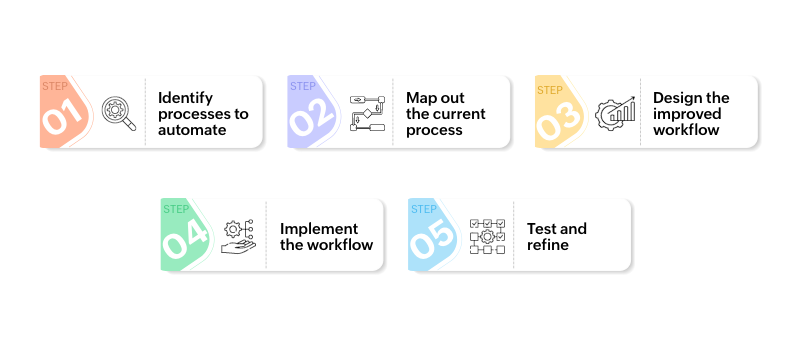- HOME
- Know Your Tech
- Mastering approval workflows: A step-by-step guide
Mastering approval workflows: A step-by-step guide
- Last Updated : March 26, 2025
- 17 Views
- 4 Min Read
Just like traffic lights manage busy intersections, approval workflows keep business processes running smoothly. Are your operations stuck at key points, with documents lost in endless email chains? In today’s customer-focused world, this can hurt productivity and profits.
Approval workflows are structured, automated systems that route requests through designated reviewers. They ensure necessary approvals are obtained quickly and clearly.
Having well-designed approval workflows is crucial. They boost efficiency, ensure transparency, maintain compliance, and reduce errors. In this guide, we’ll help you master these key systems to boost your organization's efficiency.
Understanding approval workflows
Core components
Every approval workflow operates together seamlessly, where each part plays a key role. The requestor starts the process by submitting a request for approval. Approvers decide the direction of the flow. Workflows are the connectors, while decision points are where approvals or rejections happen.
Types of approval workflows
Approval workflows come in various forms, each suited to different needs. Simple linear workflows have one approver, while multi-step workflows involve several approvers working either one after another or all at once. Conditional workflows are a bit more complicated and require approvals based on specific criteria.
Common use cases
Organizations use approval workflows to streamline operations and ensure oversight for many functions, including:
- Purchase orders
- Invoice approvals
- Document reviews
- Vacation requests
- Content publication processes
Creating effective approval workflows: A 5-step guide

Step 1: Identify processes to automate
Start by finding where problems arise. Look for bottlenecks and inefficiencies that slow your operations, and focus on repetitive, time-consuming tasks that follow clear rules and involve specific stakeholders. These tasks represent readily automatable opportunities that can yield quick benefits.
Step 2: Map out the current process
Like architects create blueprints before building, you need a clear view of your current process. Develop flowcharts that show each step, who's involved, and how long each step usually takes. This mapping can reveal hidden redundancies, bottlenecks, and pain points.
Step 3: Design the improved workflow
Now's your chance to redesign the process. Define roles and responsibilities clearly, set precise approval rules to remove uncertainty, and configure notifications to keep the process moving. You can then decide if sequential or parallel approvals will boost efficiency. An ideal workflow balances thoroughness and speed, ensuring oversight without delays.
Step 4: Implement the workflow
Implementation requires careful planning—choose the automation software that fits your needs and set it up according to your design. Integrate it with existing systems like CRM or ERP for smooth data flow, and train all participants thoroughly to ensure successful adoption.
Step 5: Test and refine
Testing is vital for success, so conduct thorough tests using realistic scenarios that mimic actual conditions. Then gather feedback from all stakeholders and make adjustments. This improves performance and user experience. Remember, the first version is rarely perfect—refinement is an ongoing journey.
Avoiding common pitfalls
Bottlenecks
Approval bottlenecks hinder business, so it's a good idea to set up escalation procedures for delayed approvals. Consider delegating when key approvers are unavailable, and use analytics to spot recurring bottlenecks to implement proactive solutions.
Lack of clarity
Unclear processes lead to confusion and mistakes. Document approval policies clearly and create visual workflow representations. When everyone knows their responsibilities, the process flows more smoothly.
Overly complex workflows
Overly complex workflows create more issues than they solve—the best workflows balance control with efficiency. Focus on simplicity and user-friendliness by cutting redundant steps and unnecessary approvals.
Ignoring user feedback
The best insights often come from daily users. Create official ways for feedback and plan regular reviews with important stakeholders. Continuous refinement based on experience keeps workflows effective as business needs change.
The benefits of approval workflow software
Employee empowerment
Well-designed workflows act like guardrails, not straitjackets—they provide structure while allowing autonomy. This cuts down on micromanagement and increases job satisfaction, as employees know their roles and how they contribute.
Improved data integrity and auditability
Approval workflows create a permanent record of every action and decision. This digital trail keeps data consistent and provides documentation for compliance, which reduces the risk of data manipulation.
Fostering a culture of continuous improvement
Approval workflows generate valuable metadata for insights on both approvals and operations. This data helps make workflow management a flexible system that boosts efficiency.
Enabling scalability and business agility
Well-designed workflows adapt to changing business conditions—as your organization grows, these automated processes can manage more volume and complexity. This happens without increasing overhead.
Reduced shadow IT
Standardized workflows function like well-maintained highways, offering straight-forward, efficient routes. Without them, employees create their own paths, leading to inconsistencies and security risks. Formalized workflows reduce variability and dependence on unauthorized solutions.
Achieving seamless approval workflows
Mastering approval workflows is about creating digital paths that guide work efficiently. By following this guide, you can turn approval processes from bottlenecks into strategic advantages. Remember, improving workflows is a continuous journey, not a one-time task.
In a world where agility shapes market leadership, streamlined approval workflows are essential. They give your organization the operational backbone to move quickly and accurately. The real question is not whether you can afford to invest in optimization, but whether you can afford not to.
 Szhruthi Boopathy
Szhruthi BoopathyPassionate product marketer specializing in low-code and AI-powered app development. When I'm not crafting compelling content and video collaterals, you'll find me immersed in the world of painting or lost in a good book.











